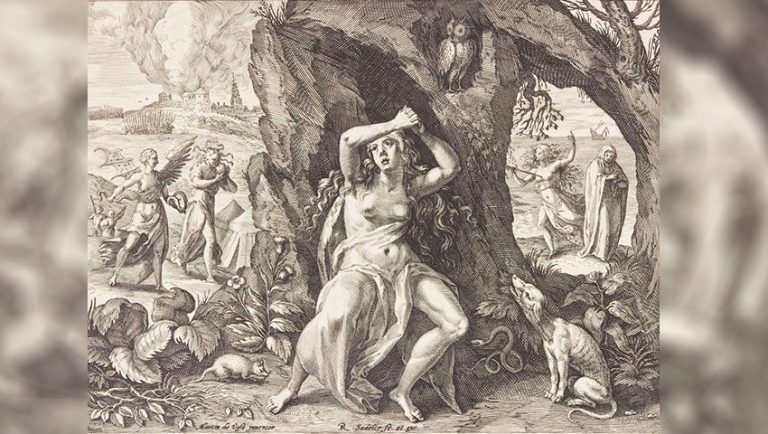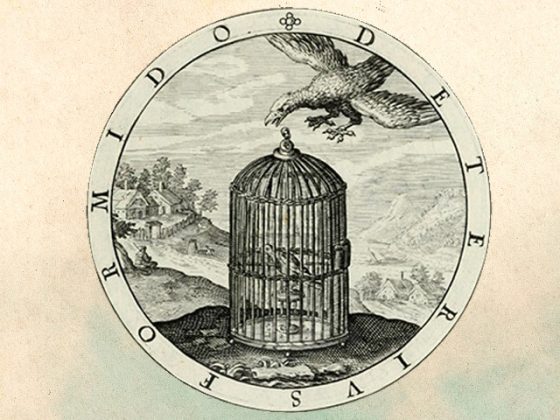Dear readers:
I am sending you the engraving that bears the name…
…TRISTITIA
─‘Sadness’─

It belongs to a four-part series on negative human traits. The series was engraved and published in 1592 in Cologne ─Germany─ by Raphael Sadeler (1560-1628) according to the drawing of the Flemish painter Maarten de Vos (1532-1603).
In this engraving we can see in the foreground a young woman, half-naked, with her hands raised ─Tristitia, ‘sadness'─. She is sitting in front of a cave. Around her are four animals: an owl, a serpent, a rat and a howler dog. To the left of the central plane, a woman with the head of serpents ─a medusa─ devouring a heart ─Invidia, ‘envy'─, and a character with a devil's wing and an angel's wing holding a serpent with both hands ─Zelotypia, ‘jealousy'─. To the right of the central plane, a woman pierced by a spear ─personification of despair─ and a woman praying: lamentation.
In the background, the siege of a city ─left─ and a shipwreck ─right─.
Dear friends, what is all this?
The artist wanted to show us where our animical and psychological weaknesses can take us when we enter into FASCINATION OR IDENTIFICATION with the impressions that we receive throughout our lives and in the course of our days.
When we FORGET OURSELVES we fall into inner misfortune and our aggregates take advantage of our HALLUCINATION to manifest themselves in various ways and thus lead us toward our own confusion and MADNESS.
The engraving clearly points to our Essence ─half-naked due to a lack of values─ and surrounded by some animalistic entities, among them a rat ─an allegory of lustful states─, a serpent ─symbol of passions hidden within ourselves─, a howling dog ─which represents, not fidelity in this case, but the howls that our fears and instincts provoke─; finally, in the upper central part we see an owl, a small animal that invites us to always be in a state of alert so as not to fall victim to unpleasant impressions that can appear at any moment of our existence.
To the left of the central plane, as we have already mentioned, we can see a medusa ─a form of our animal Ego─ that walks devouring a heart. Certainly, when we are IDENTIFIED with the events of everyday life, many of our aggregates quickly try to demoralize us, as that medusa is doing. The “I” destroys our feelings and plunges us into depression.
Likewise, our spiritual life becomes a rather strange duality. On the one hand it seems that we have an essential or divine part ─the man with the angelic wing─ and on the other that same man represents a dark state ─the same man with a dark wing or bat wing─; this is the EGO in its plurality.
To the right of the central plane we clearly see our own Essence pierced by a spear. This reminds us of those times when we are filled with profound moral pain and are looking for comfort in some way…
The woman we see praying symbolizes the psychological lamentation we enter into just when we seek a state of inner calm through prayer or meditation. We must never forget that, in the face of every crisis that strikes us, we must quickly take refuge in MEDITATION. INTERIORIZATION is a door that opens to provide us with intimate rest and self-control.
In the background, the city that we see under siege is our PSYCHOLOGICAL CITY that ends up engulfed in egoic flames with the consequent self-destruction of our psychic apparatus. And, likewise, the boat or ship that we see shipwrecked in the upper right part of the engraving alludes to the shipwreck of our inner work when WE HAVE FORGOTTEN OURSELVES.
Something interesting to note is the fact that this engraving is addressed to a woman ─she is feminine─, so our translation is presented as if it were a woman who speaks ─sadness─.
The mother of worries, because of how the sentence is structured, is anxiety rather than jealousy, and what the sentence says is that anxiety does not want the things that are approaching to arrive.
Let us now look at the translation of the Latin phrase:
«Non annis sed victa situ, sed et obsita pannis
In gemitu insomnem duco moestisima vitam
Afflictam obtundi me desperatio, fusam
Invidia absumit, tum me sine fine procellis
Zelotypa inuoluit, curarum prodiga Mater,
Anxia vestigans, quae non velit obuia ferri:
Ac nisi Diua suam mihi Commiseratio dextram
Porrigat, hac equidem non unquam fasce leuabor».
Translation: ‘Defeated, not by the years, but by the situation, and moreover covered with rags, very sad, I lead my life without sleep, amidst moaning; when I am already afflicted, despair weakens me; when I prostrate, envy consumes me; then jealousy envelops me with endless turmoil, and anxiety, prodigal Mother of worries, in search of things that are approaching, does not want them to come near: and unless divine compassion extends its right hand to me, continuing in this way, I will certainly never again lighten myself of the burden.'
I add a few quotations for you to be reflected upon:
“The ultimate human philosophy is to be prepared for whatever may come.”
Quevedo
“What is a philosopher? A man who, if you listen to him, will surely make you freer than all the praetors.”
Epictetus
“The customs of the philosophers are not in conformity with their precepts, but if they lived as they teach, they would teach how to live.”
Seneca
“Philosophy is a superior pathology.”
Hebbel
“Philosophy is the story of human error with a few sparks of light.”
Othon Gruppe
EX AEQUO ET BONO.
─‘In a fair and good way.'─
KWEN KHAN KHU





